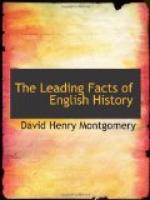A few years later (1711) a periodical appeared, called the Spectator. It was published daily, and Addison, its chief contributor, soon made it famous. Each number consisted of an essay hitting off the follies and foibles of the age, and it was regularly served at the breakfast tables of people of fashion along with their tea and toast.
One of the greatest merits of the Spectator was its happy way of showing that wit and virtue are after all better friends than wit and vice. Neither this little magazine nor the newspapers of that time dared to publish a single line of parliamentary debate. But they marked the humble beginning of that vast organized power, represented by the daily press of London, which discusses everything of interest throughout the world.
515. Death of the Queen.
The ingratitude of public men and the furious quarrels of politicians so teased and vexed the Queen that she at last fell into a fatal illness. Her physician wrote to Dean Swift, “I believe sleep was never more welcome to a weary traveler than death was to her.” When she laid down the scepter (1714) she left no heir to the throne, and so the power of the Stuarts (S415) came to an end.
According to the terms of the Act of Settlement (S497) the crown now passed to George, Elector of Hanover, a Protestant descendant of James I of England. (See Table, p. 323.) James Edward, son of James II, believed to the last that his half-sister, Queen Anne, would name him her successor;[1] instead of that it was she who first dubbed him the “Pretender” (S491).
[1] Anne and the so-called “Pretender” were children of James II by different mothers.
516. Summary.
The whole reign of Anne was taken up with the strife of political parties at home, and the War of the Spanish Succession abroad. The Whigs (S479) were always intriguing through the Duchess of Marlborough and other leaders to keep up the war and to keep out the so-called “Pretender”; the Tories (S479), on the other hand, were just as busy through Mrs. Masham and her coadjutors in endeavoring to establish peace, and with it the Divine Right of Kings (SS419, 429).
The extreme Tories hoped for the restoration of the Roman Catholic Stuarts in the person of James Edward, the so-called “Pretender.” The War of the Spanish Succession resulted in the defeat of Louis XIV and the confirmation of that Act of Settlement (S497) which secured the English crown to a Protestant prince.
GENERAL REFERENCE SUMMARY OF THE STUART PERIOD
1603-1714 (Commonwealth, 1649-1660)
I. Government. II. Religion. III. Military Affairs. IV. Literature and Learning. V. General Industry and Commerce. Vi. Mode of Life, Manners, and Customs
I. Government
517. The Divine Right of Kings; the Civil War; the “Glorious Revolution” of 1688.




